All issues

Volume 39, Issue 3
Displaying 1-23 of 23 articles from this issue
- |<
- <
- 1
- >
- >|
Regular Articles
-
Yuto Takekawa, Yuki Sato, Yoshiaki Yamaki, Mei Imai, Kazuma Noto, Masa ...2016 Volume 39 Issue 3 Pages 301-307
Published: March 01, 2016
Released on J-STAGE: March 01, 2016
JOURNAL FREE ACCESS FULL-TEXT HTML
Supplementary materialDietary and biliary cholesterol absorption contributes to the maintenance of tight control of cholesterol homeostasis. Cholesterol is present as mixed micelles formed by bile salts and phospholipids in the intestinal lumen. Recently, Niemann–Pick C1-Like 1 (NPC1L1) transporter was identified as being critical for cholesterol absorption. However, the uptake mechanism of an enveloped substrate of NPC1L1 in whole lipid emulsion particles remains unclear. In this study, we investigated the uptake mechanism of a substrate of NPC1L1 in lipid emulsion particles. We also investigated whether these particles containing cholesterol can improve the intestinal absorption of other lipophilic components via NPC1L1. The uptake of lysophosphatidylcholine (LPC)-4,4-difluoro-5-(4-phenyl-1,3-butadienyl)-4-bora-3a,4a-diaza-s-indacene-3-propionic acid saccinimidyl ester (BODIPY), a fluorescently labeled phospholipid, in lipid emulsion particles containing cholesterol (1 µM) was significantly increased compared to that without cholesterol in Caco-2 cells. On the other hand, its increased uptake was significantly inhibited by ezetimibe, a selective inhibitor of NPC1L1. These results suggested that not only cholesterol but also some components in lipid emulsion particles are taken up into enterocytes via NPC1L1. We also examined an approach to improve intestinal absorption of a poorly absorbed water-insoluble component, coenzyme Q10 (CoQ10), by this mechanism. The uptake of CoQ10 in lipid emulsion particles containing cholesterol was significantly increased compared to that without cholesterol. Its increased uptake was significantly inhibited by ezetimibe. Though it is still not clear whether CoQ10 is a substrate of NPC1L1, there is a potential for improvement of the absorption of poorly absorbed components by lipid emulsion particles containing cholesterol. Graphical Abstract Fullsize ImageView full abstractDownload PDF (696K) Full view HTML
Graphical Abstract Fullsize ImageView full abstractDownload PDF (696K) Full view HTML -
Tomomi Akita, Michiko Horiguchi, Chihiro Ozawa, Hiroshi Terada, Chikam ...2016 Volume 39 Issue 3 Pages 308-312
Published: March 01, 2016
Released on J-STAGE: March 01, 2016
JOURNAL FREE ACCESS FULL-TEXT HTMLPulmonary carcinoma is a major cause of cancer-related death worldwide. Because the prognosis remains poor, the development of novel therapeutic approaches is highly desirable. In this study, we investigated the effect of Tamibarotene (Am80), a retinoic acid derivative, on the growth of human lung adenocarcinoma cell line A549. Our ultimate goal in this study is to provide pulmonary carcinoma therapy with a new approach. First, we treated A549 cells with Am80 to clarify the effect of cell-growth inhibition. Am80 significantly reduced the viability of A549 cells in a dose- and time-dependent manner. The IC50 value, which was determined using CellTiter-Glo Luminescent Cell Viability assay, of Am80 and all-trans retinoic acid (ATRA) against A549 cells at 6 d was 49.1±8.1 µM and 92.3±8.0 µM, respectively. Furthermore, Am80 reduced the anchorage-independent cell-growth ability of A549 cells. However, it was not an apoptosis-mediated mechanism. These results suggest that Am80 can be used as an effective, novel cell-growth inhibitor in lung adenocarcinoma. Graphical Abstract Fullsize ImageView full abstractDownload PDF (837K) Full view HTML
Graphical Abstract Fullsize ImageView full abstractDownload PDF (837K) Full view HTML -
Shinji Oshima, Kazuhiko Senoo, Akio Negishi, Hayato Akimoto, Kousuke O ...2016 Volume 39 Issue 3 Pages 313-322
Published: March 01, 2016
Released on J-STAGE: March 01, 2016
Advance online publication: December 23, 2015JOURNAL FREE ACCESS FULL-TEXT HTMLArticle 25-2 of the Japanese Pharmacists’ Act was revised in June 2014, establishing the position of pharmacists as “advisors on the use of pharmaceuticals.” Prior to the Act’s revision, we investigated the perceptions of patients and pharmacists about pharmacists’ roles using a social science methodology. We also examined current opinions and necessary factors for the future growth and development of pharmacists. This questionnaire survey was conducted using an internet method. Patients and pharmacists answered 12 questions. Responses from 529 patients and 338 pharmacists were analyzed. For all items, pharmacists’ awareness of their roles exceeded patients’ awareness of the roles. In this study, the difference between pharmacist and patient awareness was larger than in similar research conducted in the United States. The greatest difference was observed in three items: “Understanding the effects of the drugs the patients are taking” (rate of high ratings: pharmacists 80.2%, patients 37.8%), “Understanding the health changes caused by the drugs dispensed to the patients” (pharmacists 80.2%, patients 28.4%), and “Consciously protecting patients from the adverse effects of drugs” (pharmacists 82.8%, patients 42.2%), indicating role discrepancy. Partition analysis indicated the three factors for a pharmacist to be regarded as a drug therapy or medication specialist: “The patient regards the pharmacist as his/her family or regular pharmacist,” “The pharmacist is making it easy for a patient to talk with him/her” and “The pharmacist is aware of a patient’s use of products other than prescribed drugs, such as over the counter (OTC) medications or health foods and nutritional supplements.” Future efforts are necessary to resolve role discrepancy and implement ongoing monitoring. Graphical Abstract Fullsize ImageView full abstractDownload PDF (1149K) Full view HTML
Graphical Abstract Fullsize ImageView full abstractDownload PDF (1149K) Full view HTML -
Akihisa Itoh, Yuuki Akagi, Hitoshi Shimomura, Takao Aoyama2016 Volume 39 Issue 3 Pages 323-328
Published: March 01, 2016
Released on J-STAGE: March 01, 2016
JOURNAL FREE ACCESS FULL-TEXT HTMLBisphosphonates are antiosteoporotic agents prescribed for patients with osteoporosis. Drug package inserts for bisphosphonate supplements indicate that their bioavailability is reduced by high levels of metal cations (Ca2+, Mg2+, etc.). However, standards for these cations in water used for taking risedronate have not been defined. Here, we examined the effect of calcium and magnesium in mineral waters on the bioavailability of the third-generation bisphosphonate, risedronate, following oral administration in rats. As risedronate is unchanged and eliminated renally, risedronate absorption was estimated from the amount excreted in the urine. Risedronate was dissolved in mineral water samples and administered orally at 0.35 mg/kg. Urine samples were collected for 24 h after dosing. Risedronate was extracted from urine using ion-pair solid-phase cartridges and quantified by HPLC with UV detection (262 nm). Cumulative recovery of risedronate was calculated from the amount excreted in the urine. The 24-h recovery of risedronate from evian® (0.32±0.02% [mean±standard deviation (S.D.)], n=4) and Contrex® (0.22±0.05%) mineral waters was significantly lower than that from tap water (0.47±0.04%, p<0.01). Absorption of risedronate in calcium chloride and magnesium chloride aqueous solutions of the same hardness (822 mg/L) was 54% (0.27±0.04%) and 12% (0.51±0.08%) lower, respectively, compared with ultrapure water; suggesting that absorption of risedronate declines as the calcium concentration of mineral waters increases. Consumption of mineral waters containing high levels of calcium (80 mg/L or above), such as evian® and Contrex®, is therefore not recommended when taking risedronate. Graphical Abstract Fullsize ImageView full abstractDownload PDF (584K) Full view HTML
Graphical Abstract Fullsize ImageView full abstractDownload PDF (584K) Full view HTML -
Ryo Kawashima, Masaki Uchida, Tsutomu Yamaki, Kazuo Ohtake, Tomomi Hat ...2016 Volume 39 Issue 3 Pages 329-335
Published: March 01, 2016
Released on J-STAGE: March 01, 2016
Advance online publication: December 25, 2015JOURNAL FREE ACCESS FULL-TEXT HTMLA novel system for delivering recombinant human growth hormone (rhGH) that is noninvasive and has a simple method of administration is strongly desired to improve the compliance of children. The aim of this study was to investigate the potential for the intranasal (i.n.) co-administration of rhGH with poly-L-arginine (PLA) as a novel delivery system by evaluating the effects of the concentration and molecular weight of PLA on the nasal absorption of rhGH. The influence of the formation of insoluble aggregates and a soluble complex in the dosage formulation on nasal rhGH absorption was also evaluated by size-exclusion chromatography and ultrafiltration. PLA enhanced the nasal absorption of rhGH at each concentration and molecular weight examined. Nasal rhGH absorption increased dramatically when the PLA concentration was 1.0 % (w/v) due to the improved solubility of rhGH in the formulation. A delay in rhGH absorption was observed when the molecular weight of PLA was increased. This appeared to be because the increase in molecular weight caused the formation of a soluble complex. It seems that the PLA concentration affects the absorption-enhancing effect on rhGH, while the molecular weight of PLA affects the time when the maximum plasma rhGH concentration was reached (Tmax) of rhGH after i.n. administration, mainly because of the interactions among rhGH, PLA, and additives. Therefore, the transnasal rhGH delivery system using PLA is considered to be a promising alternative to subcutaneous (s.c.) injection if these interactions are sufficiently controlled. Graphical Abstract Fullsize ImageView full abstractDownload PDF (737K) Full view HTML
Graphical Abstract Fullsize ImageView full abstractDownload PDF (737K) Full view HTML -
Kang Li, Dun Ding, Ming Zhang2016 Volume 39 Issue 3 Pages 336-342
Published: March 01, 2016
Released on J-STAGE: March 01, 2016
JOURNAL FREE ACCESS FULL-TEXT HTMLCerebral ischemia/reperfusion (I/R) injury is a major cause of acute brain injury. The pathogenetic mechanisms underlying I/R injury involve apoptosis, inflammation and oxidative stress. Osthole—a plant coumarin compound—has been reported to protect against focal cerebral I/R-induced injury in rats. However, the mechanism remains unknown. Here we hypothesize that osthole acts through inhibition of apoptosis during focal cerebral I/R injury in rats. We induced cerebral I/R injury by middle cerebral artery occlusion (MCAO) for 2 h followed by reperfusion. We randomly assigned 60 rats to three groups (20 rats per group): sham-operated, vehicle-treated I/R, and osthole-treated I/R. We treated rats intraperitoneally with osthole (40 mg/kg) or vehicle 30 min before cerebral ischemia. We harvested the brains for infarct volume, brain water content, histological changes and terminal deoxynucleotidyl transferase-mediated deoxyuridine triphosphate nick-end labeling (TUNEL) staining as well as cleaved caspase-3, bax, and bcl-2 levels 24 h after reperfusion. Osthole treatment significantly attenuated cerebral dysfunction and histologic damage induced by I/R injury. Moreover, osthole-treated rats had a dramatic decrease in apoptotic neuronal cells along with a decrease in bax and cleaved caspase-3. The bcl-2 levels increased. Osthole treatment protects the brain from cerebral I/R injury by suppressing cell apoptosis. Thus, osthole may represent a novel practical strategy to prevent cerebral I/R injury. Graphical Abstract Fullsize ImageView full abstractDownload PDF (2228K) Full view HTML
Graphical Abstract Fullsize ImageView full abstractDownload PDF (2228K) Full view HTML -
Yutaro Hazama, Toshihisa Maekawa, Ryotaro Miki, Shinji Oshima, Yuya Eg ...2016 Volume 39 Issue 3 Pages 343-352
Published: March 01, 2016
Released on J-STAGE: March 01, 2016
JOURNAL FREE ACCESS FULL-TEXT HTMLTacrolimus (TL) ointment is a topical treatment for atopic dermatitis, a disease that exhibits various skin conditions. The effect of skin pathologies on the systemic absorption of TL and related side effects remains unknown. This study aimed to investigate factors affecting the cutaneous absorption of TL. We prepared various skin models in hairless rats by tape stripping, injection of prophlogistic material solution (PMS), and continuous subcutaneous adrenaline (Adr) infusion. In vivo absorption studies were conducted, with measurements of transepidermal water loss (TEWL) and skin blood flow as physiological parameters. Very little TL absorption was observed through intact skin. Greater TL absorption was noted in skins with high TEWL values and fully stripped skin with PMS injections. In contrast, Adr infusion, which reduced skin blood flow, resulted in decreased TL absorption through fully stripped skin. Combined use of TL and Adr on skin with PMS injections resulted in suppression of TL absorption. Our results revealed that TL absorption following topical application is affected by alterations in the skin barrier, blood flow, and vascular permeability. We propose an administration plan for TL in a flowchart as a means of preventing systemic side effects. Graphical Abstract Fullsize ImageView full abstractDownload PDF (975K) Full view HTML
Graphical Abstract Fullsize ImageView full abstractDownload PDF (975K) Full view HTML -
Izumi Tanaka, Hiroshi Ishihara, Haruko Yakumaru, Mika Tanaka, Kazuko Y ...2016 Volume 39 Issue 3 Pages 353-360
Published: March 01, 2016
Released on J-STAGE: March 01, 2016
Advance online publication: December 25, 2015JOURNAL FREE ACCESS FULL-TEXT HTMLRadiocesium nuclides, used as a gamma ray source in various types of industrial equipments and found in nuclear waste, are strictly controlled to avoid their leakage into the environment. When large amounts of radiocesium are accidentally incorporated into the human body, decorporation therapy should be considered. Although standard decorporation methods have been studied since the 1960s and were established in the 1970s with the drug Radiogardase® (a Prussian blue preparation), application of recent advances in pharmacokinetics and ethical standards could improve these methods. Here we designed a modern dosage form of hydrogel containing cesium-absorbents to alleviate intestinal mucosa irritation due to the cesium-binding capacity of the absorbents. The effectiveness of the dosage form on fecal excretion was confirmed by quantitative mouse experiments. The total cesium excretion rate of the crystal form (1.37±0.09) was improved by the hydrogel form (1.52±0.10) at the same dose of Prussian blue, with a longer gastrointestinal tract transit time. Using a mouse model, we compared the effects of several drugs on fecal and urinary excretion of internal cesium, without the use of absorbents. Only phenylephrine hydrochloride significantly enhanced cesium excretion (excretion rate of 1.17±0.08) via the urinary pathway, whereas none of the diuretic drugs tested had this effect. These findings indicate that modifying the dosage form of cesium absorbents is important for the decorporation of internal radiocesium contamination.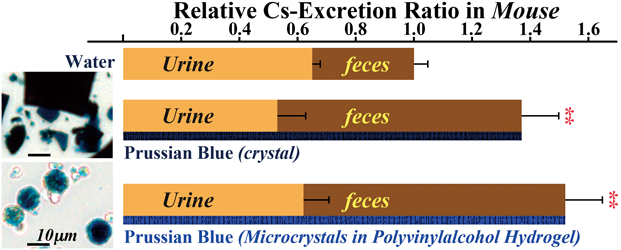 Graphical Abstract Fullsize ImageView full abstractDownload PDF (7899K) Full view HTML
Graphical Abstract Fullsize ImageView full abstractDownload PDF (7899K) Full view HTML -
Kenta Shimokawa, Kazumi Wakasugi, Rei Tomonaga, Ken Utsunomiya, Hirota ...2016 Volume 39 Issue 3 Pages 361-367
Published: March 01, 2016
Released on J-STAGE: March 01, 2016
JOURNAL FREE ACCESS FULL-TEXT HTMLWe evaluated the effects of 5-fluorouracil (5-FU) metabolic inhibitors, gimeracil or uridine, on the hepatic disposition of 5-FU after application to the liver surface in rats, aiming to enhance the availability of 5-FU in the liver. 5-FU solution with or without metabolic inhibitors was applied to the rat liver surface using a cylindrical diffusion cell. The liver, blood and the remaining solution in the diffusion cell were collected at specified times, and assayed for 5-FU content. 5-FU absorption properties were not altered by addition of gimeracil and uridine. The 5-FU concentration in the diffusion cell attachment site of the rat liver (site 1) at 0.1–0.4 M ratios of gimeracil to 5-FU was significantly higher than that of the control. On the contrary, the addition of uridine did not increase the 5-FU concentration at site 1. At a 0.1 M ratio of gimeracil to 5-FU, the maximum 5-FU plasma concentration was the lowest, and the area under the 5-FU concentration–time curve at site 1 was 3.4 times greater than that of the control. We demonstrated that applying 5-FU with gimeracil to the rat liver surface could increase the availability of 5-FU in the liver.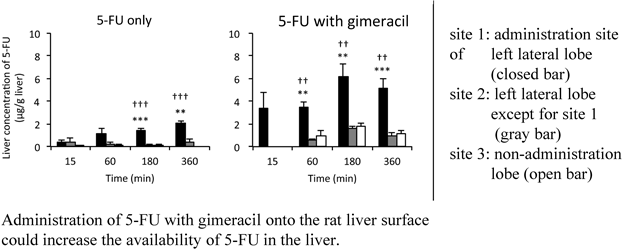 Graphical Abstract Fullsize ImageView full abstractDownload PDF (604K) Full view HTML
Graphical Abstract Fullsize ImageView full abstractDownload PDF (604K) Full view HTML -
Ayumu Asai, Tomoyuki Okuda, Tomoyo Yamauchi, Yuka Sugiura, Hirokazu Ok ...2016 Volume 39 Issue 3 Pages 368-377
Published: March 01, 2016
Released on J-STAGE: March 01, 2016
Advance online publication: January 09, 2016JOURNAL FREE ACCESS FULL-TEXT HTMLMost safety evaluations of dry powder inhalers (DPIs) using cultured cells have been performed with dry powder formulations dissolved in a medium. However, this method is not considered to be suitable to evaluate the safety of inhaled dry powder formulations correctly since it cannot reflect the actual phenomenon on the respiratory epithelial surface. In this study, we established a novel in-vitro safety evaluation system suitable for DPIs by combining an air–liquid interface cultured cell layer and a device for dispersing dry powders, and evaluated the safety of candidate excipients of dry powders for inhalation. The safety of excipients (sugars, amino acids, cyclodextrins, and positive controls) in solutions was compared using submerged cell culture systems with a conventional 96-well plate and Transwell®. The sensitivity of the cells grown in Transwell® was lower than that of those grown in the 96-well plate. Dry powders were prepared by spray-drying and we evaluated their safety with a novel in-vitro safety evaluation system using an air–liquid interface cultured cell layer. Dry powders decreased the cell viability with doses more than solutions. On the other hand, dissolving the dry powders attenuated their cytotoxicity. This suggested that the novel in-vitro safety evaluation system would be suitable to evaluate the safety of DPIs with high sensitivity. Graphical Abstract Fullsize ImageView full abstractDownload PDF (2731K) Full view HTML
Graphical Abstract Fullsize ImageView full abstractDownload PDF (2731K) Full view HTML -
Kento Takayama, Norihiko Tabuchi, Masahito Fukunaga, Nobuyuki Okamura2016 Volume 39 Issue 3 Pages 378-383
Published: March 01, 2016
Released on J-STAGE: March 01, 2016
JOURNAL FREE ACCESS FULL-TEXT HTMLSennoside A (SA), the main purgative constituent of Daiokanzoto (da-huang-gan-cao-tang; DKT), is generally regarded as a prodrug that is transformed into an active metabolite by β-glucosidase derived from Bifidobacterium spp. It has been suggested that antibiotics would promote dysbiosis, and thereby inhibit the purgative activity of DKT. In this study, ampicillin was administered to mice for 8 d, and the changes in the SA metabolism of SA alone and of DKT were investigated. The results showed that the SA metabolism of SA singly continued to be inhibited by ampicillin, but that of DKT was activated from day 3 under the same conditions. In order to investigate the mechanism of SA metabolism activated by DKT in the mice administered ampicillin, changes in the SA metabolism were observed in the presence of rhein 8-O-β-D-glucopyranoside (RG) in rhubarb and liquiritin in glycyrrhiza, both of which accelerated the SA metabolism. In fact, RG achieved an activation of SA metabolism similar to that by DKT. The purgative action of DKT, which was continued treatment of the ampicillin, was significantly greater than that by SA alone, and it was shown that RG was involved in this effect. We also analyzed changes in the intestinal microbiota before and after administration of ampicillin. No Bifidobacteria were detected throughout the treatment, but the population of Bacteroides was significantly increased after 3 d under the same conditions. Taken together, these results strongly suggested that the RG in DKT changed the function of Bacteroides and thereby allowed DKT to metabolize SA. Graphical Abstract Fullsize ImageView full abstractDownload PDF (653K) Full view HTML
Graphical Abstract Fullsize ImageView full abstractDownload PDF (653K) Full view HTML -
Takayuki Matsumoto, Shun Watanabe, Maika Iguchi, Makoto Ando, Mirai Od ...2016 Volume 39 Issue 3 Pages 384-393
Published: March 01, 2016
Released on J-STAGE: March 01, 2016
JOURNAL FREE ACCESS FULL-TEXT HTMLWe investigated the relationship between noradrenaline (NAd)-induced contractions, endothelial function, and hypertension in femoral arteries isolated from spontaneously hypertensive rats (SHR). In the femoral arteries of SHR, vs. age-matched control Wistar Kyoto (WKY) rats, contractions induced by NAd were increased. These effects were enhanced by endothelial denudation, which abolished the differences between the two groups. NAd-induced contractions were enhanced by nitric oxide (NO) synthase inhibition, and further increased by the blockade of endothelium-derived hyperpolarizing factor (EDHF). Conversely, NAd-induced contractions were inhibited by cyclooxygenase (COX) inhibition. In addition, in SHR arteries, acetylcholine-induced relaxation was reduced, and components of endothelium-derived factors were altered, such as increased COX-derived vasoconstrictor prostanoids, reduced EDHF, and preserved NO-mediated relaxation. In the femoral arteries of SHR, the production of prostanoids [6-keto prostaglandin (PG)F1α (a metabolite of prostacyclin (PGI2), PGE2, and PGF2α] and COX-2 protein were increased compared with that in WKY rats. By contrast, contractions induced by beraprost (a stable PGI2 analogue), PGE2, and U46619 (thromboxane/prostanoid receptor agonist) were similar between the SHR and WKY groups. Thus, NAd-induced femoral arterial contractions are augmented in SHR resulting from endothelial dysfunction and increased COX-derived vasoconstrictor prostanoid levels.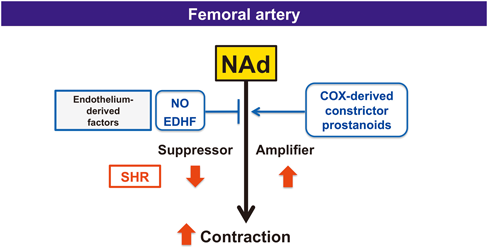 Graphical Abstract Fullsize ImageView full abstractDownload PDF (1117K) Full view HTML
Graphical Abstract Fullsize ImageView full abstractDownload PDF (1117K) Full view HTML -
Yumiko Suzuki, Tomoyuki Okuda, Hirokazu Okamoto2016 Volume 39 Issue 3 Pages 394-400
Published: March 01, 2016
Released on J-STAGE: March 01, 2016
Advance online publication: December 25, 2015JOURNAL FREE ACCESS FULL-TEXT HTMLCationic polymers are being studied as non-viral gene delivery vectors. Poly{N-[N-(2-aminoethyl)-2-aminoethyl]aspartamide} (PAsp(DET)) and their block copolymers with poly(ethylene glycol), PEG-PAsp(DET), have been reported as efficient biodegradable non-viral vectors which form a polyplex with plasmid DNA (pDNA). However, the polyplexes are not stable because PAsp(DET) and PEG-PAsp(DET) are easily subjected to hydrolysis; therefore, they need to be prepared on site. In this study, using the biodegradable polycations as non-viral vectors, PAsp(DET) and PEG-PAsp(DET), we investigated the effects of L-leucine (Leu) on the polyplex. We prepared solutions and dry powders with and without Leu. Both dry powders had large and porous particles and Leu acted as a dispersing agent. The transfection activity of the sample solutions decreased within a month. However, the decrease in the transfection activity was partially suppressed by the dry powder with Leu at 5 and 25°C at 3 months. Furthermore, transfection experiments revealed that Leu exhibited a pDNA-stabilizing effect in the solution and dry powder. Similar results were observed for pDNA integrity, where a polyplex was formed in the dry powder. The results suggest that Leu is a candidate stabilizer to protect pDNA from degradation.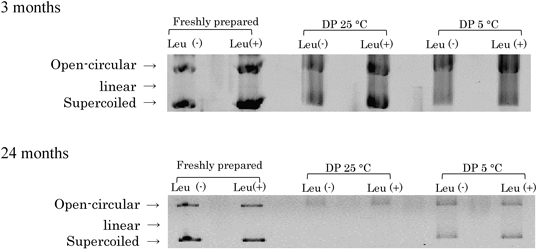 Graphical Abstract Fullsize ImageView full abstractDownload PDF (1176K) Full view HTML
Graphical Abstract Fullsize ImageView full abstractDownload PDF (1176K) Full view HTML -
Thiol Oxidation and CarbonylationTeppei Takahashi, Tomoyoshi Terada, Hajime Arikawa, Kazuha Kizaki, Hir ...2016 Volume 39 Issue 3 Pages 401-408
Published: March 01, 2016
Released on J-STAGE: March 01, 2016
Advance online publication: December 26, 2015JOURNAL FREE ACCESS FULL-TEXT HTMLWe investigated the quantitation of oxidative chemical modifications, such as thiol oxidation and carbonylation, in medical-grade human serum albumin (HSA) preparations, in comparison with those of healthy and diseased subjects. Four kinds of HSA products were obtained from three major suppliers in Japan. Eight male collegiate students and six healthy male volunteers were recruited as the young (21.6 years) and older (57.2 years) groups, respectively. Four male stable patients (64.3 years) treated with regular hemodialysis (HD) also enrolled in this study. Quantitative analyses for thiol oxidation and carbonylation were performed using HPLC and spectroscopic methods, respectively. Structural characterization was further investigated by differential scanning calorimetry (DSC) and circular dichroism (CD) spectropolarimetry. Significantly larger amounts of thiol-oxidized and carbonylated HSA products were observed than HSA obtained from healthy subjects. In the structural characterization, the midpoint temperature of the denaturation curve (Tm) analyzed by DSC was relatively high, and may have been caused by the added albumin-specific stabilizers, and CD-resolved secondary structure showed that HSA products had a helical conformation. Commercial HSA products for clinical use have a more thermally stable state and remain in a helix-rich structure, even though their specific amino acids (mainly Cys and Lys residues) are oxidatively modified.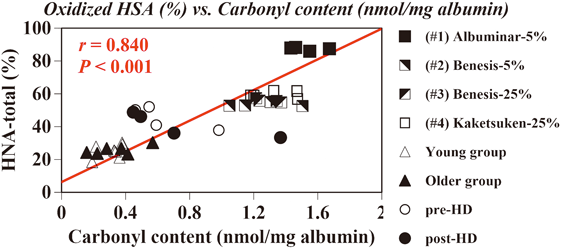 Graphical Abstract Fullsize ImageView full abstractDownload PDF (1029K) Full view HTML
Graphical Abstract Fullsize ImageView full abstractDownload PDF (1029K) Full view HTML -
Eun Ju Jeong, Jonghwan Jegal, Jongmin Ahn, Jinwoong Kim, Min Hye Yang2016 Volume 39 Issue 3 Pages 409-414
Published: March 01, 2016
Released on J-STAGE: March 01, 2016
Advance online publication: December 22, 2015JOURNAL FREE ACCESS FULL-TEXT HTMLDioscorea oppositifolia is a well-known edible and traditional medicine for the treatment of gastrointestinal diseases. In our previous study, D. oppositifolia exhibited both pancreatic lipase inhibition and an anti-adipogenesis effect in vitro. This study was performed to investigate the anti-obesity effect of D. oppositifolia on high-fat diet-induced obese mice. Female ICR mice were fed a high-fat diet with the 100 mg/kg of D. oppositifolia n-BuOH extract for 8 weeks. The high-fat diet mice received the 15 mg/kg Orlistat orally as a positive control. The body weight, parametrial adipose tissue weight, and the levels of triglyceride (TG), total cholesterol (TC), and low density lipoprotein (LDL)-cholesterol in blood serum of female ICR mice were significantly decreased by feeding a high-fat diet with the n-BuOH extract of D. oppositifolia. An inhibitory effect of D. oppositifolia extract on dietary fat absorption was also clearly shown. The D. oppositifolia sample was found to contain 3,5-dimethoxy-2,7-phenanthrenediol and (3R,5R)-3,5-dihydroxy-1,7-bis(4-hydroxyphenyl)-3,5-heptanediol as main components based on its phytochemical analysis. The present study is the first report of the anti-obesity effect by D. oppositifolia n-BuOH extract using an established disease model. The increase in fecal fat excretion by treatment of D. oppositifolia may be an effective approach for treating obesity and related diseases. Graphical Abstract Fullsize ImageView full abstractDownload PDF (498K) Full view HTML
Graphical Abstract Fullsize ImageView full abstractDownload PDF (498K) Full view HTML -
Souleymane Coulibaly, Hiroki Minami, Maho Abe, Nami Furukawa, Ryo Ono, ...2016 Volume 39 Issue 3 Pages 415-422
Published: March 01, 2016
Released on J-STAGE: March 01, 2016
JOURNAL FREE ACCESS FULL-TEXT HTMLPublic concern regarding the transport of air pollutants from mainland East Asia to the leeward area by the prevailing westerlies in spring and winter monsoon has been growing in recent years. We collected total suspended particle (TSP) in Beijing, a metropolis of China located windward of Japan, in spring (late February 2011–May 2011) and in winter (November 2012–early February 2013), then analyzed metals, ions, and organic compounds and mutagenicity, and compared the pollution levels with samples collected at two Japanese metropolises (Osaka and Nagoya) during the same periods. The medians of concentration of TSP and other factors in Beijing were much larger than those in the Japanese metropolises. Especially, the concentrations of polycyclic aromatic hydrocarbons (PAHs) were remarkably high in Beijing in winter, and the median of total PAHs concentration in Beijing was 62–63 times larger than that in the Japanese sites. The mutagenicity of TSP from Beijing toward Salmonella typhimurium YG1024, with and without a mammalian metabolic system (S9 mix), was 13–25 times higher than that from the Japanese sites in winter. These results suggest that air pollution levels in Beijing are very high compared with those at the two Japanese metropolises we evaluated. The diagnostic ratios of PAHs and nitrated polycyclic aromatic hydrocarbons (NPAHs) suggest that the major sources of PAHs and NPAHs in Beijing are different from those at the two Japanese sites in winter, and that the major source in Beijing is coal/biomass combustion. Graphical Abstract Fullsize ImageView full abstractDownload PDF (485K) Full view HTML
Graphical Abstract Fullsize ImageView full abstractDownload PDF (485K) Full view HTML
Notes
-
Takahito Ando, Yoshiaki Shimoo, Masayoshi Nakasato, Hisahiro Yoshida2016 Volume 39 Issue 3 Pages 423-427
Published: March 01, 2016
Released on J-STAGE: March 01, 2016
JOURNAL FREE ACCESS FULL-TEXT HTMLTo provide safe dental care, it is important to minimize the pain associated with the initial injection of the local anesthetic. For this purpose, a topical anesthetic is preliminarily applied to the area where a needle will be inserted in a clinical setting. In this study, we prepared new topical anesthetic formulations with favorable intra-oral retentivity and an excellent anesthetic effect, and clinically evaluated their efficacy. We used 4% lidocaine solution as an anesthetic drug and gelatin, agar, and a food thickener as a base to prepare new topical anesthetic formulations. The subjects rested in a supine position on a chair for dental practice prior to the following experiments. Firstly, about 0.2 g of the sample was applied at a test site. One minute later, the sample was removed, and a 30 G dental injection needle was inserted into the test site. The agar/gelatin-based formulation containing gelatin of 2% and agar of 1% had a moderate solidity at 25°C and a moderate fluidity at 37°C. This formulation showed a significantly greater depth than any of the commercially available topical anesthetics. The results of the present study demonstrated that the agar/gelatin-based formulation showed an excellent analgesic effect against pain associated with needle insertion. Graphical Abstract Fullsize ImageView full abstractDownload PDF (279K) Full view HTML
Graphical Abstract Fullsize ImageView full abstractDownload PDF (279K) Full view HTML -
Shoko Yamamoto, Kisaburo Deguchi, Masamichi Onuma, Noriaki Numata, Yas ...2016 Volume 39 Issue 3 Pages 428-434
Published: March 01, 2016
Released on J-STAGE: March 01, 2016
JOURNAL FREE ACCESS FULL-TEXT HTMLCollagen tripeptide (CTP) is a collagen hydrolysate containing a high concentration of tripeptides with a Gly-X-Y sequence, such as Gly-Pro-Hyp. To test the effects of this preparation, we compared the absorption of peptides in humans after ingestion of a tripeptide fraction of CTP (CTP-100), a CTP preparation containing ca. 50% Gly-X-Y tripeptides (CTP-50), and a collagen peptide that did not contain tripeptides (CP). The postprandial levels of Gly-Pro-Hyp and Pro-Hyp in the plasma increased in those subjects who ingested CTP-100 and CTP-50, and were higher with greater Gly-Pro-Hyp ingestion. This demonstrated that collagen hydrolysates were efficiently absorbed when the collagen was ingested in the tripeptide form. Gly-Pro-Hyp and Pro-Hyp were also found in the urine after ingestion of CTP-100 or CTP-50. Similar to the results for the plasma concentration, the urinary excretion of Gly-Pro-Hyp and Pro-Hyp was also dependent on the amount of Gly-Pro-Hyp ingested. This indicates that ingested Gly-Pro-Hyp and generated Pro-Hyp were relatively stable in the body and were transported to the urine in the peptide form. The concentration of Hyp-Gly in the plasma was low after the ingestion of CP and CTP-100 but higher after the ingestion of CTP-50. Overall, our results suggest that tripeptides derived from collagen are absorbed efficiently by the body.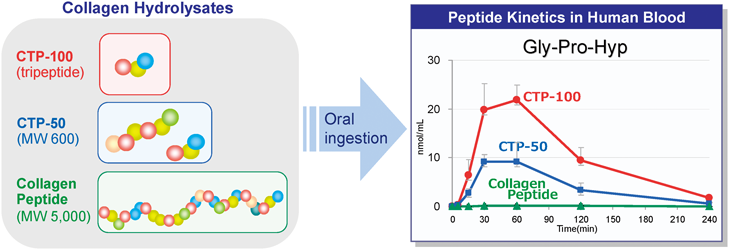 Graphical Abstract Fullsize ImageView full abstractDownload PDF (451K) Full view HTML
Graphical Abstract Fullsize ImageView full abstractDownload PDF (451K) Full view HTML -
Yuta Oshima, Kohei Seki, Masataka Shibuya, Yuki Naka, Tatsuya Yokoyama ...2016 Volume 39 Issue 3 Pages 435-439
Published: March 01, 2016
Released on J-STAGE: March 01, 2016
JOURNAL FREE ACCESS FULL-TEXT HTMLA soluble form of human intestinal lactoferrin receptor (shLFR) is identical to human intelectin-1 (hITLN-1), a galactofuranose-binding protein that acts as a host defense against invading pathogenic microorganisms. We found that recombinant shLFR, expressed in mammalian cells (CHO DG44, COS-1, and RK13), binds tightly to Sepharose 4 Fast Flow (FF)-based matrices in a Ca2+-dependent manner. This binding of shLFR to Sepharose 4 FF-based matrices was inhibited by excess D-galactose, but not by D-glucose, suggesting that shLFR recognizes repeating units of α-1,6-linked D-galactose in Sepharose 4 FF. Furthermore, shLFR could bind to both Sepharose 4B- and Sepharose 6B-based matrices that were not crosslinked in a similar manner as to Sepharose 4 FF-based matrices. Therefore, shLFR (hITLN-1) binds to Sepharose-based matrices in a Ca2+-dependent manner. This binding property is most likely related to the ability, as host defense lectins, to recognize sepharose (agarobiose)-like structures present on the surface of invading pathogenic microorganisms.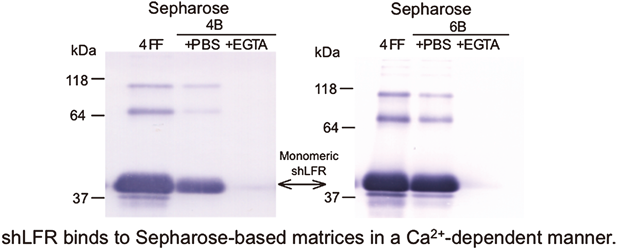 Graphical Abstract Fullsize ImageView full abstractDownload PDF (995K) Full view HTML
Graphical Abstract Fullsize ImageView full abstractDownload PDF (995K) Full view HTML -
Syu-ichi Kanno, Ayako Tomizawa, Shin Yomogida2016 Volume 39 Issue 3 Pages 440-445
Published: March 01, 2016
Released on J-STAGE: March 01, 2016
Advance online publication: December 25, 2015JOURNAL FREE ACCESS FULL-TEXT HTML
Supplementary materialAcetaminophen (APAP) is a widely used analgesic and antipyretic drug. Drug-induced liver injury from agents such as APAP is known to vary between individuals within a species. To avoid liver injury and ensure the proper use of pharmaceutical products, it is important to be able to predict such risks using genetic information. This study evaluated the use of quantitative real-time polymerase chain reaction (RT-qPCR) to identify mRNAs (carried in the blood of male ddY mice) capable of predicting susceptibility to APAP-induced hepatotoxicity. Screening was performed on samples obtained at 18 h after treatment from mice that had been orally treated with 500 mg/kg APAP. APAP-induced hepatotoxicity was seen in 60% of the mice, and the mortality rate was 12%. Blood APAP concentration did not differ significantly between mice with and without APAP-induced hepatotoxicity. We compared blood mRNA expression levels between mice with (positive, serious or lethal injury) and without hepatotoxicity in the APAP-treated group. The transcript levels of interleukin-encoding loci Il1β, Il10, and tumor necrosis factor (Tnf) were increased in the lethal injury group. Transcripts of the loci encoding transthyretin (Ttr) and metallothionein 1 (Mt1) showed increases in the liver injury group, while those of the glutathione peroxidase 3-encoding locus (Gpx3) were decreased. APAP hepatotoxicity was potentiated in fasted animals, although fasting did not appear to affect the level of expression of these genes. These results indicate that mRNA expression of Il1β, Il10, Tnf, Ttr, Mt1, and Gpx3 in mouse blood may provide useful surrogate markers of APAP-induced hepatotoxicity. Graphical Abstract Fullsize ImageView full abstractDownload PDF (357K) Full view HTML
Graphical Abstract Fullsize ImageView full abstractDownload PDF (357K) Full view HTML -
Satoshi Tadokoro, Naohide Hirashima, Naoko Utsunomiya-Tate2016 Volume 39 Issue 3 Pages 446-449
Published: March 01, 2016
Released on J-STAGE: March 01, 2016
JOURNAL FREE ACCESS FULL-TEXT HTMLMast cells are involved in allergic responses and undergo exocytotic release of inflammatory mediators in response to antigen stimulation. Soluble N-ethylmaleimide-sensitive factor attachment protein receptor (SNARE) proteins are involved in this membrane fusion process; some SNARE-binding proteins regulate SNARE-dependent liposome membrane fusion. SNARE-binding protein complexin II is expressed in mast cells, where it positively regulates exocytotic release after antigen stimulation. We found that complexin II suppressed SNARE-dependent membrane fusion between mast cell SNARE-containing liposomes. This inhibitory effect of complexin II was abolished when we used a structurally divergent mutant (R59H) complexin II, where Arg59 is substituted with histidine. These results suggest that complexin II negatively regulates SNARE-dependent exocytotic membrane fusion in mast cells, and this inhibitory effect is dependent upon Arg59. Graphical Abstract Fullsize ImageView full abstractDownload PDF (489K) Full view HTML
Graphical Abstract Fullsize ImageView full abstractDownload PDF (489K) Full view HTML -
Ratsupa Thammaporn, Kentaro Ishii, Maho Yagi-Utsumi, Susumu Uchiyama, ...2016 Volume 39 Issue 3 Pages 450-454
Published: March 01, 2016
Released on J-STAGE: March 01, 2016
JOURNAL FREE ACCESS FULL-TEXT HTMLNon-nucleoside reverse transcriptase inhibitors (NNRTIs) of human immunodeficiency virus type 1 reverse transcriptase (HIV-1 RT) have been developed for the treatment of acquired immunodeficiency syndrome. HIV-1 RT binding to NNRTIs has been characterized by various biophysical techniques. However, these techniques are often hampered by the low water solubility of the inhibitors, such as the current promising diarylpyrimidine-based inhibitors rilpivirine and etravirine. Hence, a conventional and rapid method that requires small sample amounts is desirable for studying NNRTIs with low water solubility. Here we successfully applied a recently developed mass spectrometric technique under non-denaturing conditions to characterize the interactions between the heterodimeric HIV-1 RT enzyme and NNRTIs with different inhibitory activities. Our data demonstrate that mass spectrometry serves as a semi-quantitative indicator of NNRTI binding affinity for HIV-1 RT using low and small amounts of samples, offering a new high-throughput screening tool for identifying novel RT inhibitors as anti-HIV drugs. Graphical Abstract Fullsize ImageView full abstractDownload PDF (546K) Full view HTML
Graphical Abstract Fullsize ImageView full abstractDownload PDF (546K) Full view HTML
Errata
-
2016 Volume 39 Issue 3 Pages 455
Published: March 01, 2016
Released on J-STAGE: March 01, 2016
JOURNAL FREE ACCESS FULL-TEXT HTMLDownload PDF (108K) Full view HTML
- |<
- <
- 1
- >
- >|